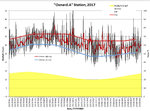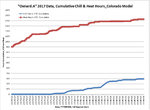I recently purchased several Acer Papmatum trees (Shindeshojo, Akane, Englishtown, Red Dragon, and Orangeola). I plan to develop most of these for bonsai (except the two weeping varieties with high grafts). They are all currently planted in pots.
I live in upstate New York in Zone 5b.
My question is what are the chill hour requirements for Acer Palmatums? How many hours minimum and in what range?
I am trying to decide whether it is best to keep these trees in my heated greenhouse which I keep at 40F over winter (works well for the tropical trees I grow in there), or to keep them in my unheated garage?
My concerns are that the temperature in my detached garage is often not much higher than outside (often just above 0Fat night in winter), which might be too cold for these trees, and that if I keep them in my greenhouse at 40F at night and higher in the day time might not be cold enough for them.
I welcome your thoughts.
I've also come up empty in my previous searches for dormancy studies on
A. palmatum. But a few years ago, I stumbled on a landscape
A. palmatum of some age in coastal Ventura, CA, zone 10a (30F-35F). But for the last 7 years we have been closer to 11A (40-45F). From the landscape jade plants the last freeze was +~10 years ago. So, I picked up a couple 1 gallons Japanese Maples and they have been through two "winters", losing their leaves or manually defoilating the mostly spent leaves in mid-December. They have budded out around late Feb. to early March. Which is before my Trident Maples (which hold their leaves longer) and after the Chinese Elms (which usually hold some leaves year-round). It should also be noted that "Sunset" magazine lists Ventura as Zone 23, subtropical thermal belt, lacking the summer heat and winter cold necessary to grow pear, apples, and peaches. Average lows 43-48F.

From my limited research, I came across 2 papers that I used to determine my chill hours or units. The 1st is "Chilling and Heat Unit Levels Affect Foliar Budbreak of Selected Red and Freeman Maple Cultivars" by Barett Wilson, et. al.
Acer rubrum is relevant because it has a range across the entire Eastern US all the way to the tip of Florida. It's been awhile since I read this paper, but essentially they determined that the Red Maples required more cumulative heat units (hours>72F) when they had lower cumulative chill hours (<45F). For example, 200 chill hours required 1700 heat hours for budbreak and 1200 chill hours only required 46 heat hours. This is referred to as the Chill Units (CU) model or Old 45 model.
Another paper, "Chilling Accumulation: its Importance and Estimation" by Byrne and Bacon of Texas A&M referenced the CU model and also the "Utah Model". The Utah Model is interesting as it assigns units and partial units for temperatures between 34F and 54F and negative units for greater than 61F. A breakdown of values is on below chart.
I had pulled the nearest weather station (2017 data) that I could locate which was 3 miles from the ocean probably has slightly higher highs and lower lows than I receive. The chart of the data with Ventura's average highs and lows overlain (from generic Google Climate Graph). The chart starts in May. You can see it has several 24 days with lows below 40F and 2 days with lows below 32F. Applying CU or Old 45F model gives a cumulative chill hour total of 293 hours from the Fall Equinox (Sept. 22nd) to late April. Based on that model, my Japanese Maples have been ending dormancy between 200-300 chill hours <45F. The heat hours do not seem to have a big impact, as I only accumulate ~120 heat hours (>72F) after leaf drop and hardly any during the span where 200 chill hours are attained and the trees break dormancy.


I favor the Utah model has I get "credit" for my temperatures between 45F and 54F. The chart of that model applied to same temperature data is below. The breakdown of the temperature range unit assignment is on the right. These are "Chill Units" and not hours. For example, 1 hour between 37-48F is 1 unit, but 1 hour at 35-36F is only 0.5 unit and 1 hour at 49-54F is 0.5 unit. In this model, I accumulate over 800 chill units from the Fall Equinox to early March. Of course, this partial credit model doesn't really help if you don't have the chill unit requirement for certain species. But I view it as capturing that higher temperature range not measured by the Old 45F model. In essence, I'm getting credit for an additional 500 "hours" of accumulated chill time between 45-54F.

All that to say, I believe you can achieve the dormancy requirements if you keep if between 40-45F. If you use artificial light on the tropicals, I would try to segregate the maples to give them as close to the normal daylight as possible.
Good Luck!




